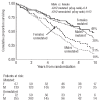The clinical significance of patients' sex in chronic lymphocytic leukemia
- PMID: 24658818
- PMCID: PMC4040913
- DOI: 10.3324/haematol.2013.101378
The clinical significance of patients' sex in chronic lymphocytic leukemia
Abstract
We examined the prognostic influence of gender in chronic lymphocytic leukemia. Data from four randomized trials (involving 1821 patients) and three registration studies of stage-A disease (involving 1299 patients) were analyzed. Overall survival at 10 years was better for women than men in all trials (27% versus 15%; P=0.0001) and in the registration series (55% versus 43%; P<0.0001). More women than men in the trials were Binet stage A-progressive (26% versus 15%), but gender was an independent predictor of survival in multivariate analysis of clinical variables (P<0.0001). Women responded better to treatment (overall response 83%) than men (71%; P<0.0001), within each stage and age group, although fewer women than men received the full treatment dose (79% versus 85%; P=0.01). Women were more likely than men to experience toxicity (85% versus 78%, P=0.01), particularly gastro-intestinal toxicity (57% versus 42%, P<0.0001). Laboratory markers in the LRF CLL4 trial showed a significantly lower incidence in women than men of unmutated IGHV genes, raised beta-2 microglobulin, CD38 and Zap-70 positivity and TP53 deletions/mutations and/or 11q deletions. We also highlight the higher male:female ratios in randomized trials versus studies of early chronic lymphocytic leukemia and monoclonal B-cell lymphocytosis. Chronic lymphocytic leukemia in women runs a more benign clinical course than in men. Gender was also an independent predictor of response, suggesting that pharmacokinetic differences between the sexes and a possible effect of estrogens may contribute to the better outcome. Understanding the reasons for the different outcome by gender may improve patients' management. (LRF CLL4 controlled-trials.com identifier: ISRCTN58585610).
Copyright© Ferrata Storti Foundation.
Figures
References
-
- Rai KR, Sawitsky A, Cronkite EP, Chanana AD, Levy RN, Pasternack BS. Clinical staging of chronic lymphocytic leukemia. Blood 1975;46(2):219–34 - PubMed
-
- Catovsky D, Fooks J, Richards S. Prognostic factors in chronic lymphocytic leukaemia: the importance of age, sex and response to treatment in survival. A report from the MRC CLL 1 trial. MRC Working Party on Leukaemia in Adults. Br J Haematol 1989;72(2):141–9 - PubMed
-
- Ailawadhi S, Yang D, Jain N, Mie Thinn M, Cozen W, Chanan-Khan A. Ethnic disparities in chronic lymphocytic leukemia survival: a SEER database review. Blood 2012;120(21):757 Abstract 757.
-
- Molica S, Mauro FR, Callea V, Gentile M, Giannarelli D, Lopez M, et al. GIMEMA CLL Study Group. A gender-based score system predicts the clinical outcome of patients with early B-cell chronic lymphocytic leukemia. Leuk Lymphoma. 2005;46:(4)553–60 - PubMed
Publication types
MeSH terms
Associated data
LinkOut - more resources
Full Text Sources
Other Literature Sources
Research Materials
Miscellaneous




